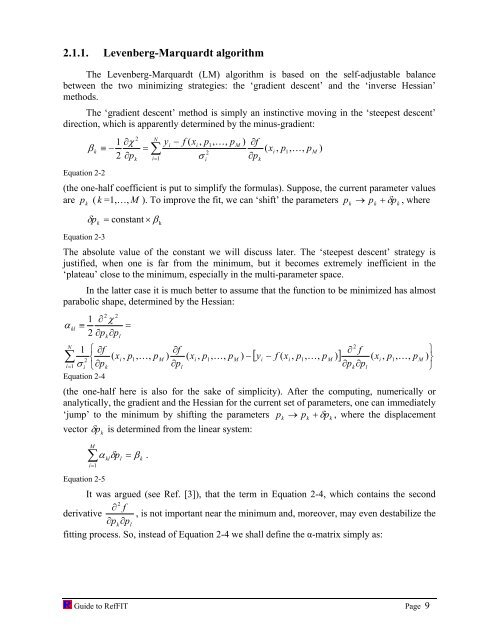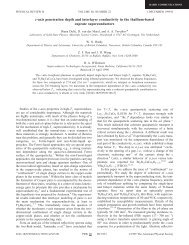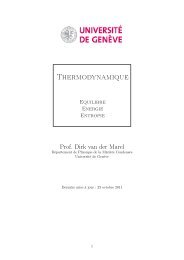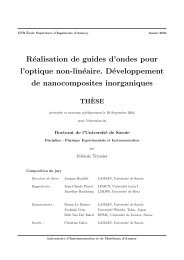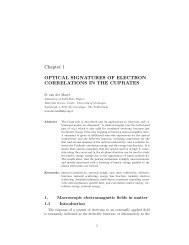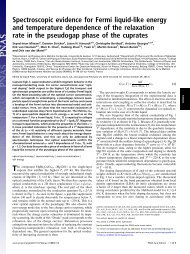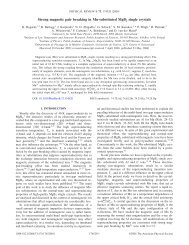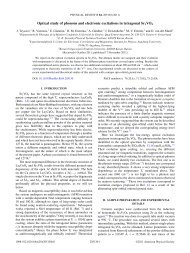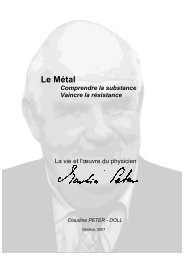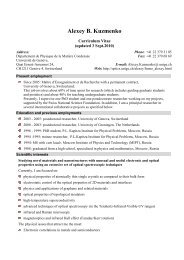software to fit optical spectra - Quantum Materials Group
software to fit optical spectra - Quantum Materials Group
software to fit optical spectra - Quantum Materials Group
Create successful ePaper yourself
Turn your PDF publications into a flip-book with our unique Google optimized e-Paper software.
2.1.1. Levenberg-Marquardt algorithm<br />
The Levenberg-Marquardt (LM) algorithm is based on the self-adjustable balance<br />
between the two minimizing strategies: the ‘gradient descent’ and the ‘inverse Hessian’<br />
methods.<br />
The ‘gradient descent’ method is simply an instinctive moving in the ‘steepest descent’<br />
direction, which is apparently determined by the minus-gradient:<br />
β<br />
Equation 2-2<br />
2<br />
1 ∂χ<br />
−<br />
2 ∂p<br />
N<br />
i i 1<br />
k ≡ = ∑ 2<br />
k i= 1 σ i<br />
y<br />
− f ( x , p , K,<br />
p<br />
M<br />
) ∂f<br />
∂p<br />
( x , p , K,<br />
p<br />
(the one-half coefficient is put <strong>to</strong> simplify the formulas). Suppose, the current parameter values<br />
are p k ( k =1,…, M ). To improve the <strong>fit</strong>, we can ‘shift’ the parameters pk → pk<br />
+ δpk<br />
, where<br />
δ p = ×<br />
k<br />
Equation 2-3<br />
constant β k<br />
The absolute value of the constant we will discuss later. The ‘steepest descent’ strategy is<br />
justified, when one is far from the minimum, but it becomes extremely inefficient in the<br />
‘plateau’ close <strong>to</strong> the minimum, especially in the multi-parameter space.<br />
In the latter case it is much better <strong>to</strong> assume that the function <strong>to</strong> be minimized has almost<br />
parabolic shape, determined by the Hessian:<br />
2 2<br />
1 ∂ χ<br />
α kl ≡<br />
2 ∂pk<br />
∂pl<br />
=<br />
N 1 ⎧ ∂f<br />
∑ 2 ⎨<br />
i= 1 σ i ⎩∂p<br />
k<br />
Equation 2-4<br />
( xi<br />
, p1,<br />
K,<br />
p<br />
M<br />
∂f<br />
)<br />
∂p<br />
l<br />
( x , p , K,<br />
p<br />
i<br />
1<br />
M<br />
) −<br />
Guide <strong>to</strong> RefFIT Page 9<br />
k<br />
i<br />
1<br />
M<br />
[ y − f ( x , p , K,<br />
p ) ]<br />
i<br />
i<br />
1<br />
)<br />
M<br />
2<br />
∂ f<br />
∂p<br />
∂p<br />
k<br />
l<br />
( x , p , K,<br />
p<br />
(the one-half here is also for the sake of simplicity). After the computing, numerically or<br />
analytically, the gradient and the Hessian for the current set of parameters, one can immediately<br />
‘jump’ <strong>to</strong> the minimum by shifting the parameters pk → pk<br />
+ δpk<br />
, where the displacement<br />
vec<strong>to</strong>r δ pk<br />
is determined from the linear system:<br />
M<br />
∑<br />
i=<br />
1<br />
Equation 2-5<br />
α δ = β .<br />
kl pl<br />
k<br />
It was argued (see Ref. [3]), that the term in Equation 2-4, which contains the second<br />
∂ f<br />
derivative<br />
∂pk<br />
∂pl<br />
2<br />
, is not important near the minimum and, moreover, may even destabilize the<br />
<strong>fit</strong>ting process. So, instead of Equation 2-4 we shall define the α-matrix simply as:<br />
i<br />
1<br />
M<br />
⎫<br />
) ⎬<br />
⎭


